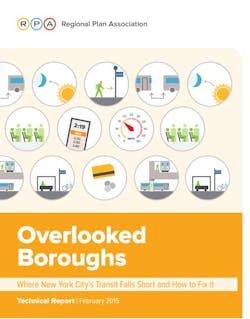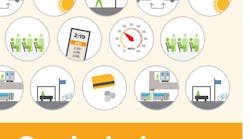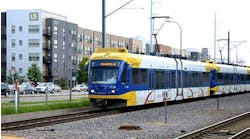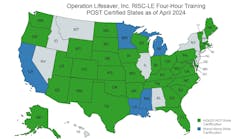The Manhattan-centric transit network has failed to keep pace with growth in population and jobs in New York City’s outer boroughs, depriving millions of residents across many communities of adequate transportation they need to get to work or school every day, a new study by Regional Plan Association shows.
The transit gap falls especially hard on lower-income households, who are less likely to own cars and rely heavily on mass transit for their daily commutes, the study says.
The RPA study, “Overlooked Boroughs: Where New York City’s Transit Falls Short and How to Fix It,” identifies the shortfalls in the bus, subway and commuter rail network and makes a series of recommendations to address these gaps.
New York City’s subway system was designed in the early 20th century to bring residents to jobs in midtown and lower Manhattan. Yet over the last two decades, commuting has grown faster within the four outer boroughs than from the boroughs to Manhattan. Some 1.7 million residents of the four outer boroughs traveled to jobs within those boroughs in 2010, an increase of 18 percent from a decade earlier. By comparison, about one million residents commuted to jobs from the outer boroughs to Manhattan, up 12 percent from 2010.
“Too many residents of Queens, Brooklyn, the Bronx and Staten Island are forced to make long and circuitous commutes every day, often going out of their way to travel relatively short distances,” said Jeffrey Zupan, RPA’s senior fellow for transportation and one of the lead authors of the study. “In the many neighborhoods that are located beyond a comfortable walking distance from a subway or railroad station, residents have to rely on slow and infrequent buses, adding to the time and inconvenience of their commutes.”
The inadequacies of the transit system are especially burdensome to the city’s lower-income residents, who are more likely to work in sectors such as retail and health care, industries with jobs spread throughout the five boroughs. Lower-income households also are less able to afford cars or taxis, and have fewer service and retail options within walking distance than more affluent neighborhoods. The higher cost of commuter rail service can be a barrier to residents who might otherwise look for reverse-commute jobs in the suburbs.
“Much of the growth in jobs, homes and travel in the coming decades will take place outside Manhattan, but that growth won’t be sustainable unless we make some very significant changes to our transit system,” said Tom Wright, president of RPA. “Good transit access plays an enormous role in expanding opportunity to education and jobs. As New York works to foster a new supply of housing to meet surging demand, we need to think more broadly about how our transit network will accommodate the city’s needs well into the 21st century.”
The report found that:
- The subway is of limited use for travel within the boroughs
- Bus service in the boroughs is slow and infrequent, and many residents need to take two or more buses to reach their destination
- The metropolitan region’s vast commuter rail network could be better utilized in the boroughs
The report recommends a comprehensive strategy to upgrade the transit system centered on three goals: creating a first-rate bus system; improving and extending subway and rail service; and making commuter rail work for borough residents.
“Overlooked Boroughs” was written by Zupan and by Richard Barone, RPA’s director of transportation programs. The authors found that residents’ access to transit would be improved through a series of short- and longer-term measures, including:
- Increase the frequency of bus service on dozens of outer-borough routes
- Run a 24-mile overground rail line running on an existing rail right-of-way from Bay Ridge in Brooklyn, through Queens, to Co-Op City in the Bronx, to carry passengers directly from one outer borough to another
- Extend the Second Avenue subway both north to the Bronx and south to Lower Manhattan
- Expand Select Bus Service on an additional eight corridors, two in each borough except for Manhattan
- Speed bus service by implementing contactless fare payment, better traffic enforcement and other measures
- Increase off-peak and reverse commute service on Metro-North in the Bronx and the Long Island Rail Road in Queens
- Reduce weekday commuter rail fares for trips within New York City
- Add LIRR Main Line capacity in order to increase reverse commute service
These recommendations followed a rigorous evaluation of existing service, with particular focus on low-income and car-less households. In addition, RPA assembled an advisory committee of transportation experts to review analysis and recommendations, and led a series of public meetings in communities across the city to gather input on residents’ needs.
The report was made possible through the support of the Robert Sterling Clark Foundation and the Rockefeller Foundation.




